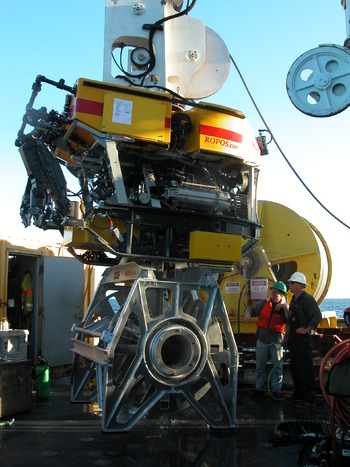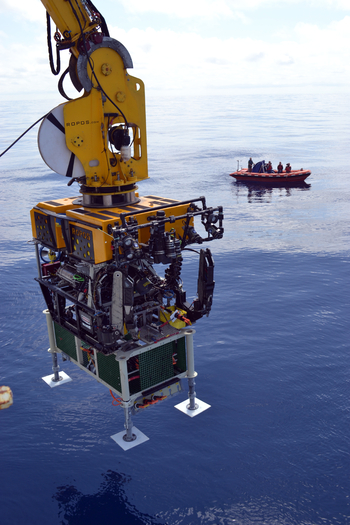
During the VISIONS'13 expedition the ROV ROPOS, installed >22,000 m of extension cables onto the seafloor using the remotely operated cable laying system (ROCLS) shown here attached to its underbelly. The cables will provide power and real-time, two-way communication to a diverse array of instruments and junction boxes.

During the UW-OOI-NSF VISIONS'13 Expedition, the remotely operated vehicle ROPOS installed three medium power J-Boxes (secondary nodes) utilizing their special 4,000 lb heavy lift capabilities. ROPOS took this RSN J-Box down on dive R1601. The broad feet on the J-Box are used for installation in heavily sedimented areas. This was an unusually calm day at sea in the NE Pacific.
Photo Credit: Mitch Elend, University of Washington.
The Canadian remotely operated vehicle (ROV) called ROPOS is a robotic vehicle used during the UW-OOI-NSF VISIONS'13 expedition. For this expedition ROPOS was configured to work at depths of up to 3000 m. The vehicle was tethered to theresearch ship the R/V Thompson (operated by the University of Washington as part of the UNOL's fleet) by a by a fiber-optic cable that allows real-time communication to and from the ship and the ROV, as well as providing power to the ROV.
During the RSN dives, ROPOS operations required three ROV people: a pilot (who operates the vehicle controls); a co-pilot (who monitors and operates the winch that pays in and hauls out the fiber-optic cable attached to ROPOS); and a navigator (who is responsible for making sure the ship and vehicle are in the desired positions). Three to five scientists typically stood watches in the ROV control room alongside the ROPOS crew to ensure that the scientific goals of the cruise are accomplished. Some of the watch standers were students who participated in the UW VISIONS'13 at-sea experiential learning course.
During the VISIONS'13 expedition, ROPOS was outfitted on numerous dives with the novel remotely operated cable laying system (ROCLS) that was used to successfully deploy > 22,000 meters of extension cables onto the seafloor. The cables, which range in length from ~ 200 m to nearly 5000 m, provide connections from the Primary Nodes (installed in 2012) to Junction Boxes and instruments installed by ROPOS during VISIONS'13.
In addition to the highly successful deployments of cables, ROPOS was used to directly power up medium power junction boxes and cabled instruments through ~4000 m long extension cables. The testing showed that ALL cables, instruments and junction boxes are functional. During the tests live HD imagery and seismic data were streamed live from the seafloor, to the ship through ROPOS's tether and to the Internet.
The vehicle also conducted significant site documentation for the installations will directly imaging of the various work sites with a variety of cameras mounted on the vehicle, including a high-definition video camera and a high-resolution digital still camera.
The vehicle is equipped with two robotic arms, called manipulators, that are used to deploy the assets as well as to collect water, geological, and biological samples.
ROPOS is operated out of Victoria, British Columbia, by the Canadian Scientific Submersible Facility.


